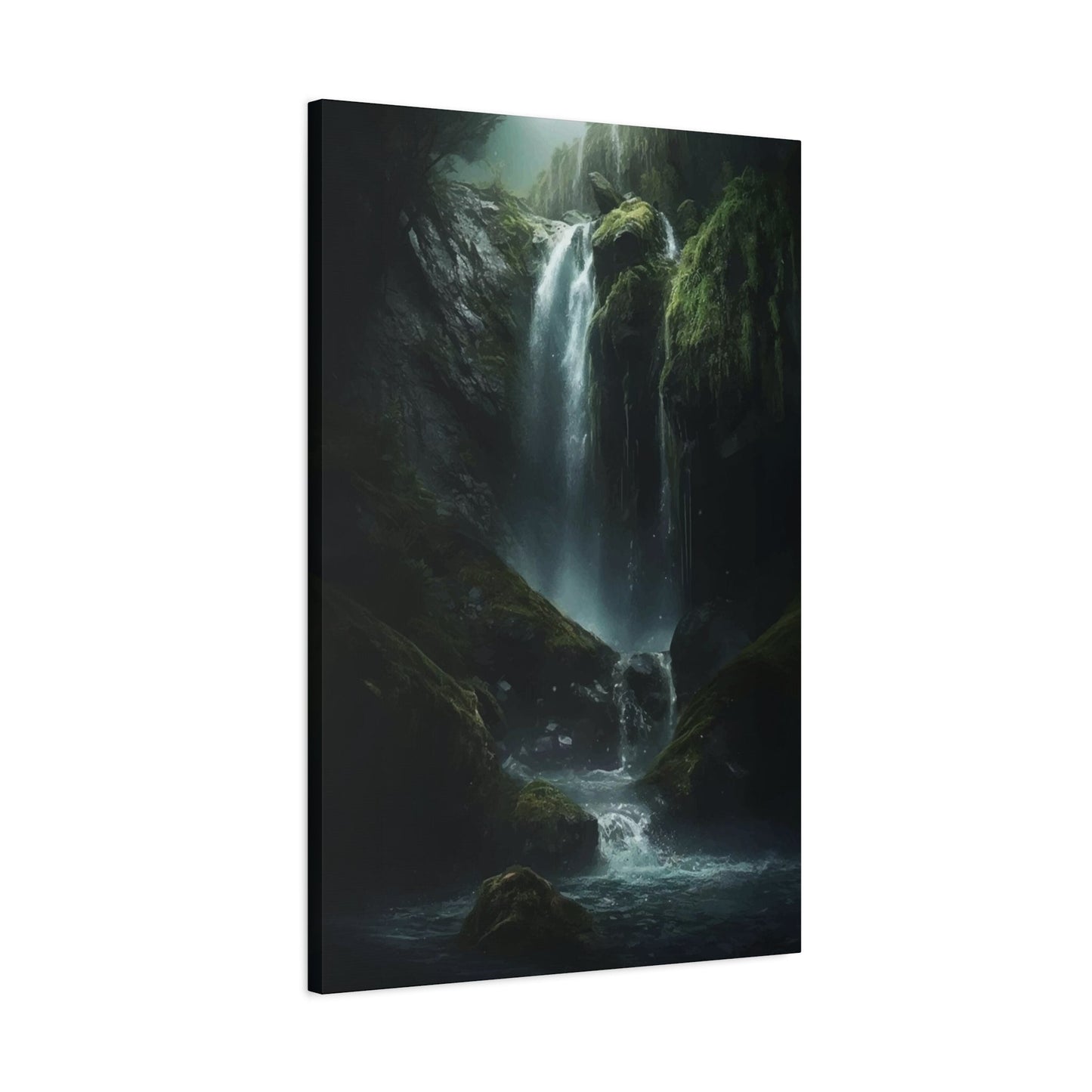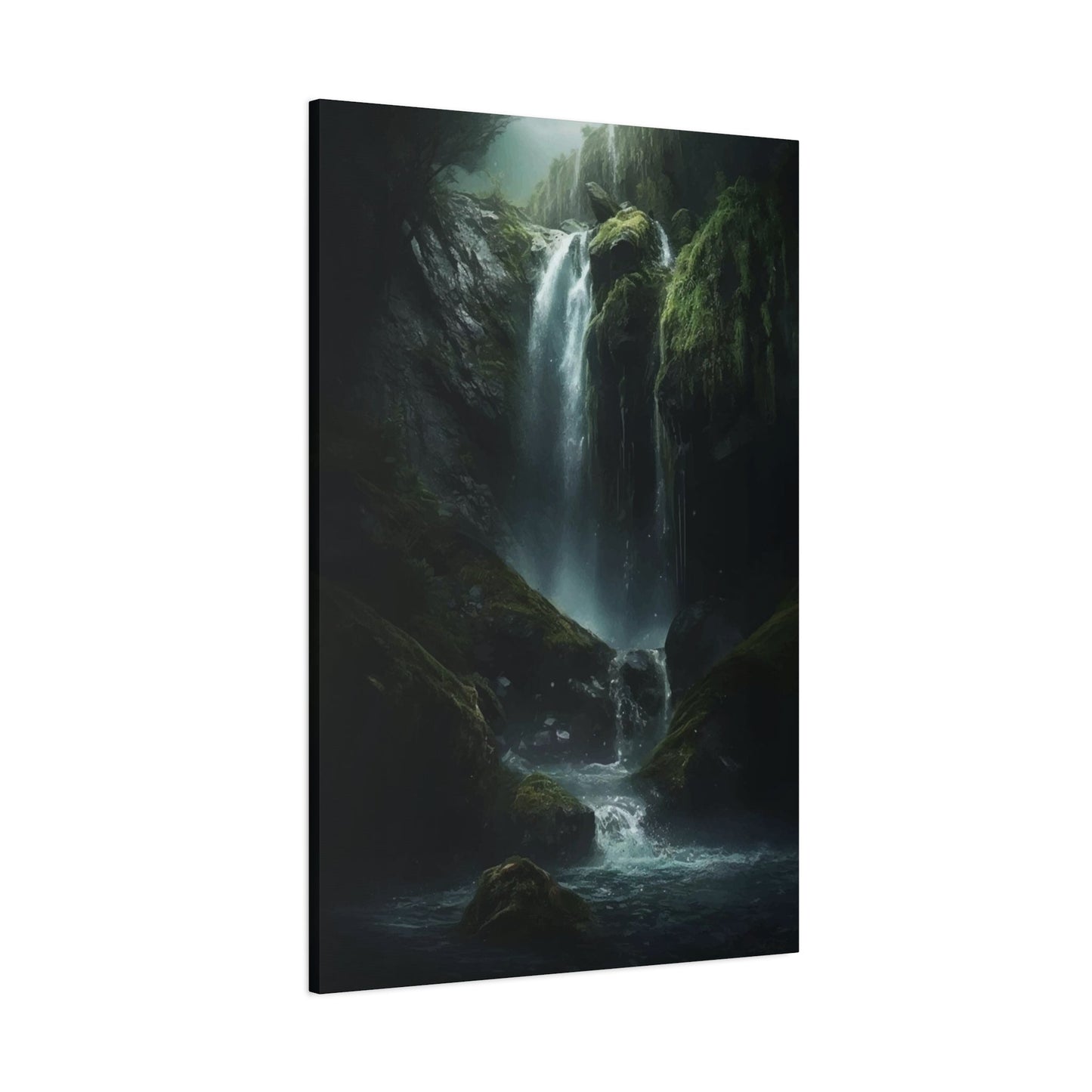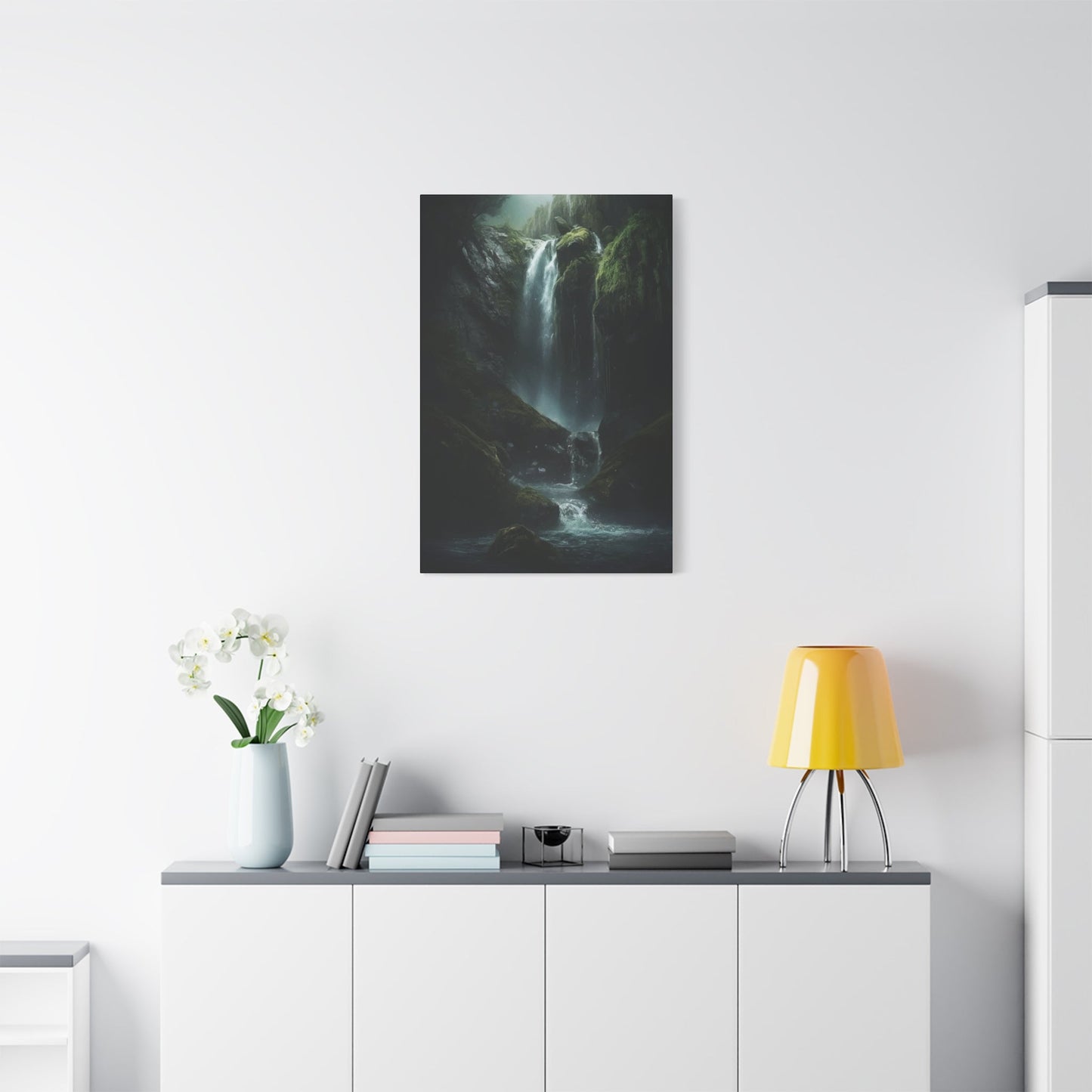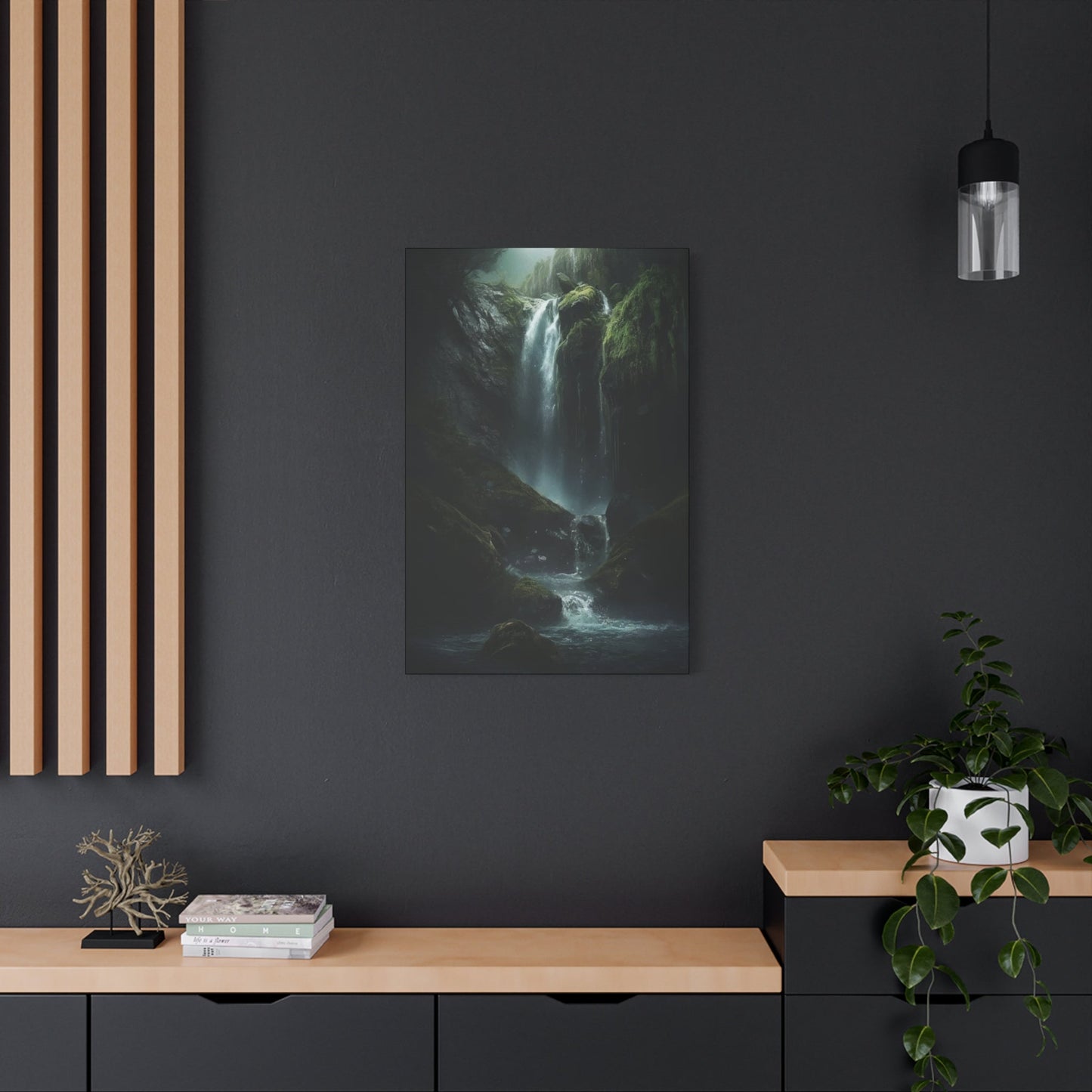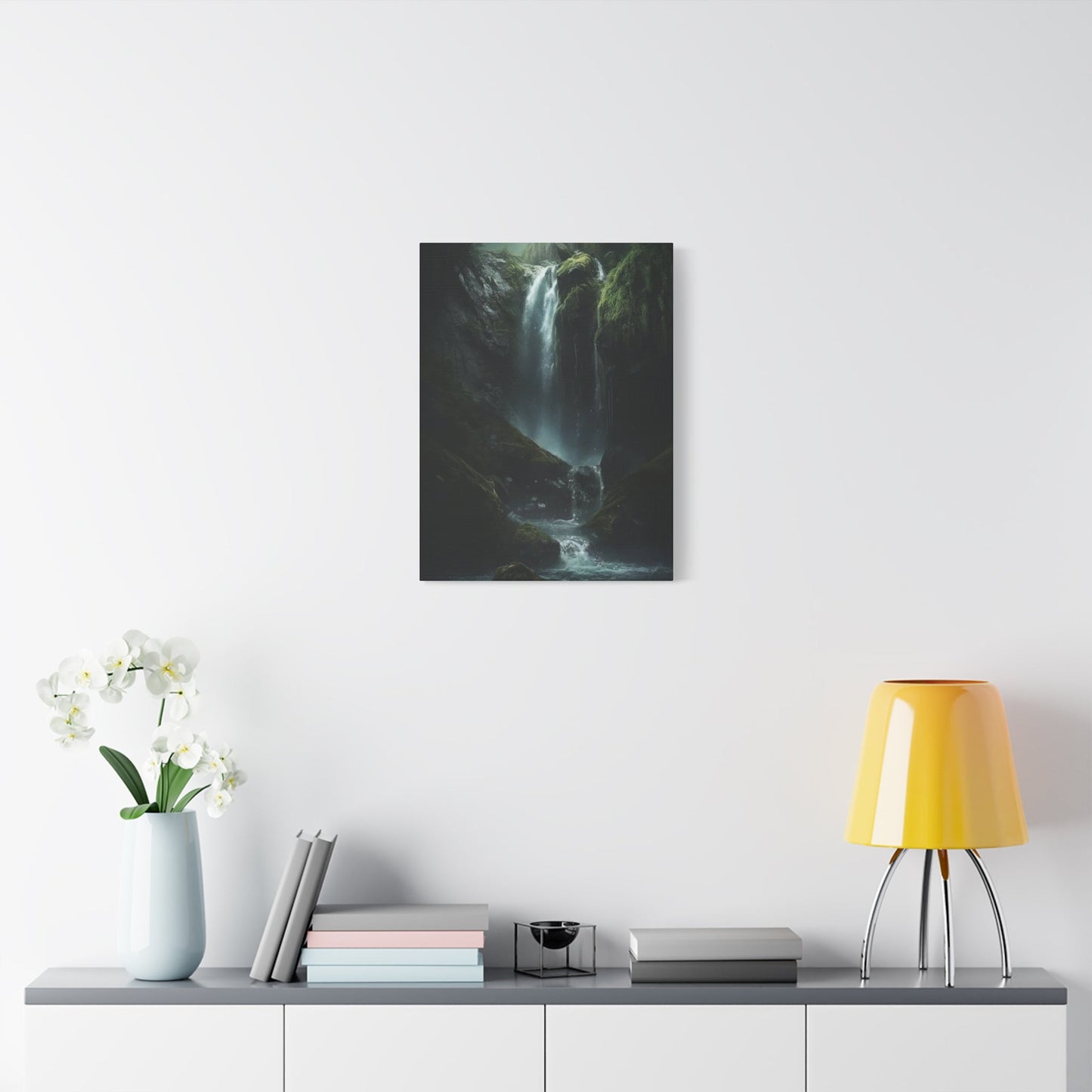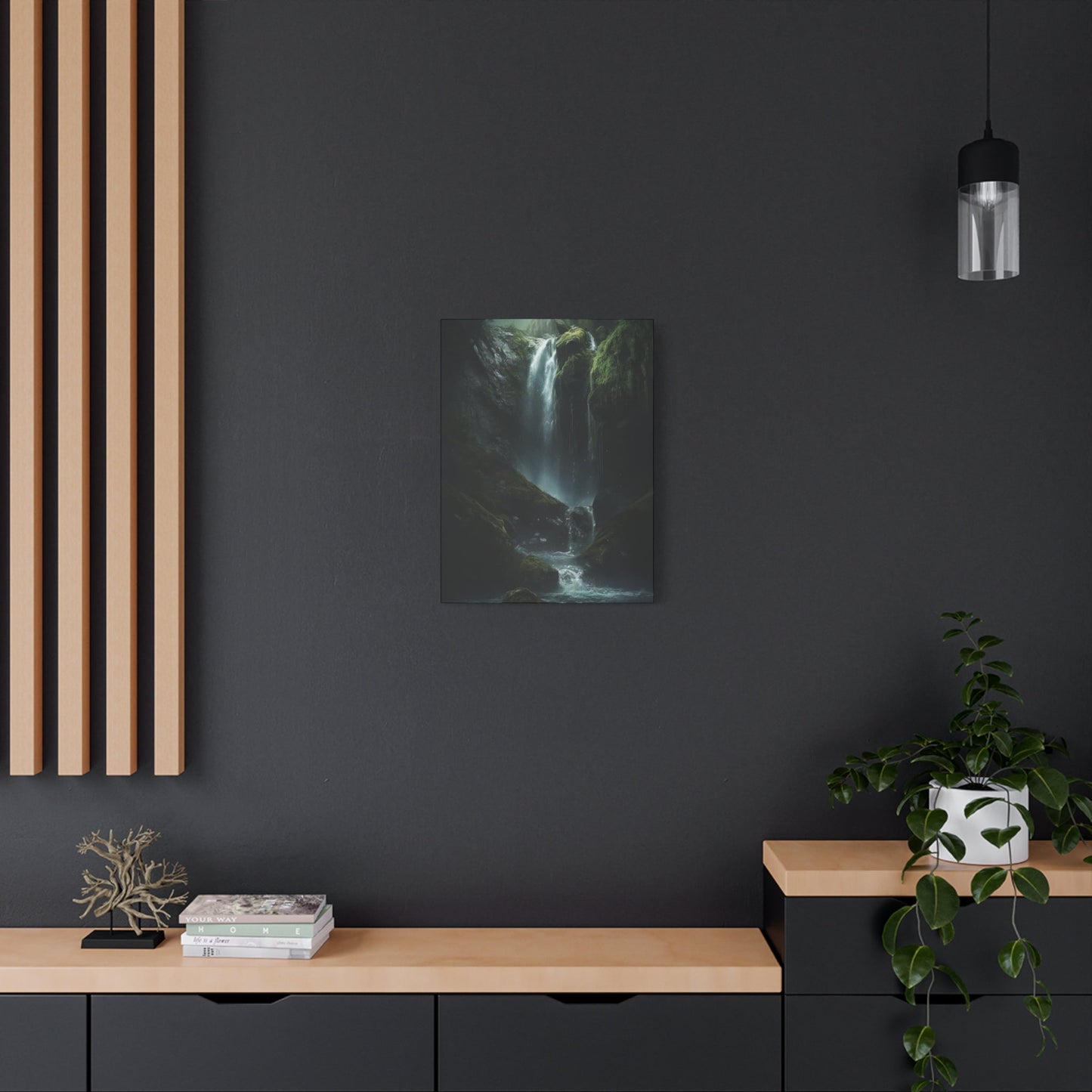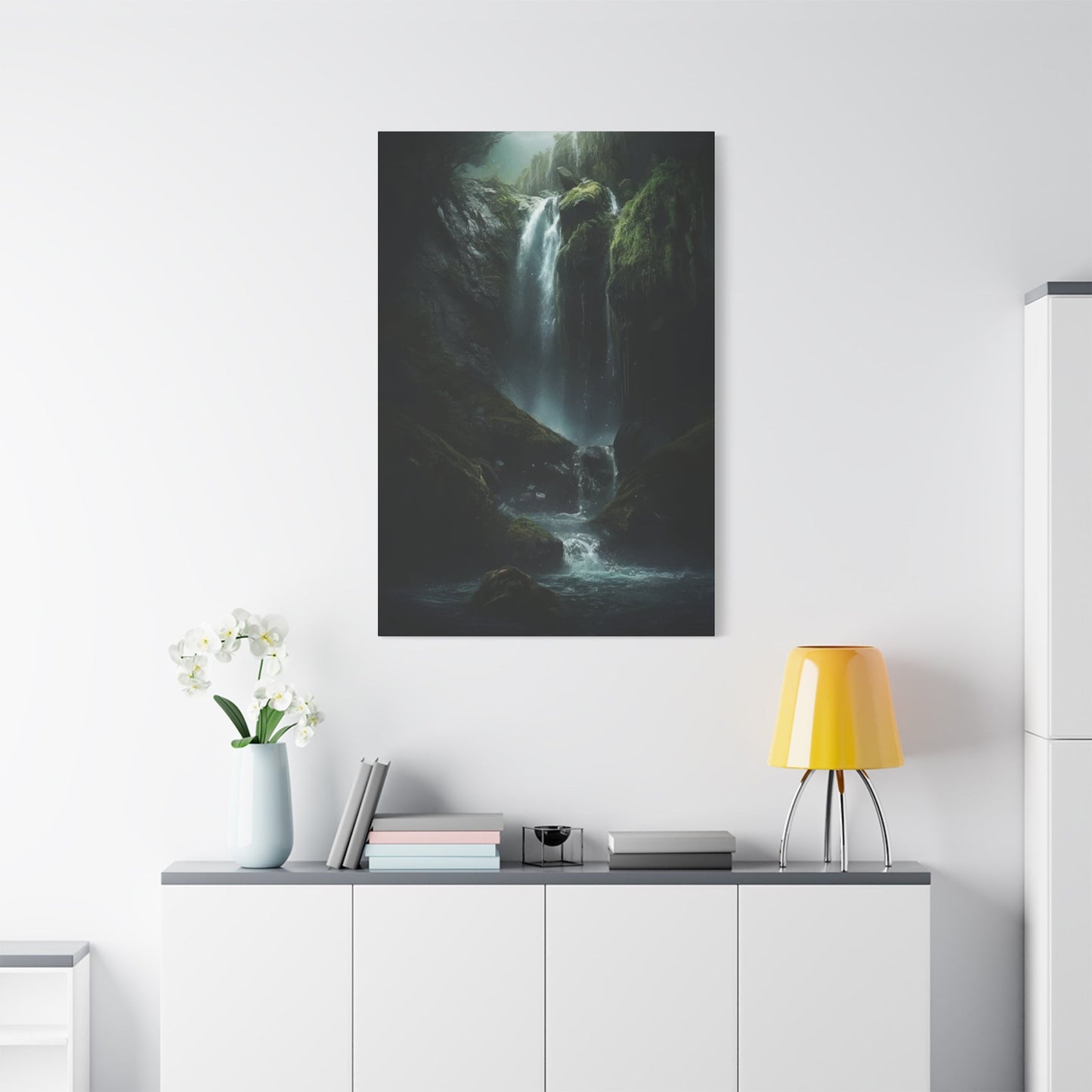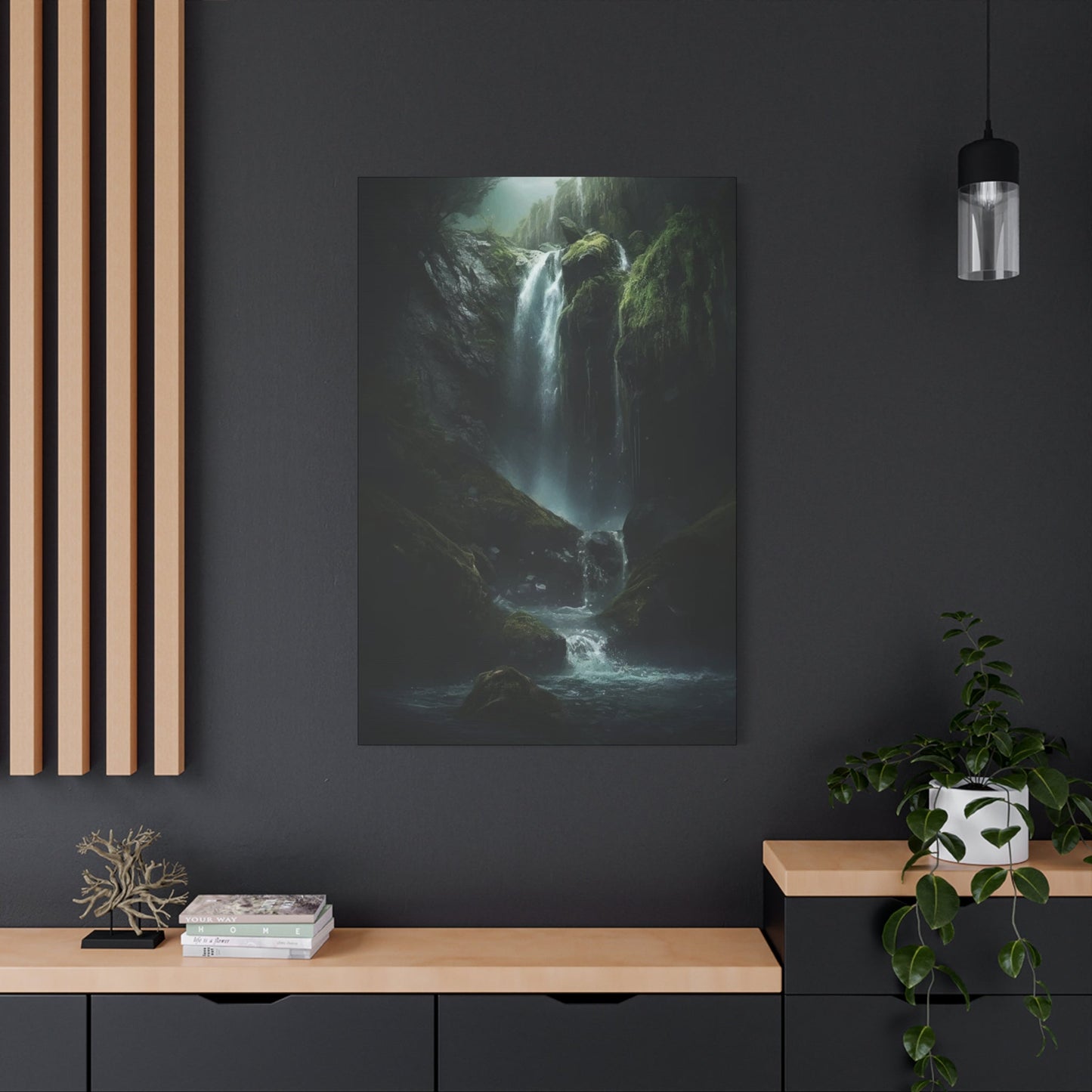DIY Waterfall Wall Art: How to Create Your Own Custom Piece Inspired by Nature
The mesmerizing quality of falling water has captivated human imagination for centuries, and incorporating this natural wonder into interior spaces through artistic representations offers a unique opportunity to connect with nature's most peaceful elements. When you introduce imagery of cascading streams into your living environment, you're not merely hanging a decorative piece on your wall—you're creating a portal to tranquility that can fundamentally alter the atmosphere of any room.
The visual impact of rushing water captured in artistic form possesses an almost magical ability to draw the eye and calm the mind simultaneously. This paradoxical quality stems from the inherent duality of flowing water itself: it represents both constant movement and eternal stillness, power and gentleness, sound and silence. When translated into visual art, these qualities manifest as a focal point that commands attention while simultaneously promoting relaxation and mental clarity.
Natural water features have been revered across cultures for their life-giving properties and spiritual significance. By bringing representations of these magnificent natural formations into residential spaces, homeowners create a connection to the wild places of our planet without leaving the comfort of their homes. This connection serves multiple purposes—aesthetic enhancement, psychological benefit, and spiritual nourishment—all combined in a single artistic choice.
The diversity available in water-themed artwork means that every individual can find something that resonates with their personal aesthetic preferences and emotional needs. From dramatic plunges over rocky cliffs to gentle cascades through lush forest settings, from tropical paradises to austere mountain landscapes, the variety ensures that there's something perfect for every taste and every interior design scheme. The beauty lies not just in the subject matter itself, but in how it's captured—the play of light on moving water, the mist rising from the base, the surrounding vegetation, and the overall composition all contribute to the final impact of the piece.
Contemporary printing technologies have made it possible to reproduce the beauty of these natural wonders with stunning clarity and vibrancy. High-resolution photography combined with advanced printing techniques means that the artwork you hang in your home can capture every detail of these majestic natural features—from individual water droplets suspended in mid-air to the subtle gradations of color in the surrounding landscape. This technological advancement has democratized access to museum-quality artwork, making it possible for anyone to own pieces that would have been prohibitively expensive just a generation ago.
Revolutionizing Your Living Environment with Flowing Water Imagery
The decision to incorporate water-themed artwork into your home represents more than a simple decorating choice—it's a commitment to creating an environment that nurtures well-being and promotes positive energy flow throughout your living space. The transformative power of these artistic pieces extends far beyond their visual appeal, influencing the mood, energy, and overall ambiance of every room they inhabit.
When strategically placed, artwork depicting rushing water can serve as the centerpiece of a room's design scheme, anchoring the entire space and providing a focal point around which other design elements naturally arrange themselves. This anchoring effect helps create cohesion in interior design, making disparate elements feel intentional and harmonious. The natural tones typically found in such imagery—blues, greens, grays, and earth tones—provide a neutral yet engaging palette that complements a wide range of color schemes and decorating styles.
The scale of these pieces matters significantly in terms of their impact on a space. A large-format piece depicting a dramatic cascade can completely alter the perceived dimensions of a room, making it feel more spacious and open while simultaneously creating an intimate connection with nature. Smaller pieces, when grouped together or placed strategically, can create rhythm and flow throughout a home, leading the eye from one space to another and creating visual continuity that enhances the overall design narrative.
One of the most compelling aspects of incorporating water imagery into home decor is its versatility across different design aesthetics. Whether your home embodies minimalist modernism, rustic farmhouse charm, coastal elegance, or traditional sophistication, there's a style of water-themed artwork that will enhance rather than compete with your existing decor. This adaptability makes these pieces excellent investment purchases, as they can transition with you through different phases of life and changing design preferences.
The emotional resonance of these pieces cannot be overstated. Coming home after a stressful day and being greeted by the serene image of cascading water provides an immediate psychological shift, signaling to your brain that you've entered a space of rest and renewal. This daily ritual of visual connection with nature's beauty can have cumulative effects on mental health and overall life satisfaction. Studies have shown that regular exposure to nature imagery, even in photographic or artistic form, can lower stress hormones, reduce anxiety, and improve overall mood stability.
Beyond the psychological benefits, these pieces also serve practical functions in interior design. They can disguise architectural flaws, draw attention away from less attractive features of a room, or create the illusion of depth in spaces that feel confined. A strategically placed piece depicting a distant cascade can make a wall seem to recede, opening up a small room and making it feel more spacious and airy.
The Tranquil Influence of Rushing Water Representations
The profound sense of peace that washes over viewers when they contemplate images of flowing water isn't coincidental—it's rooted in deep evolutionary and neurological responses that connect us to our ancient past. Our ancestors relied on water sources for survival, and the sound and sight of flowing water signaled safety, abundance, and life itself. These primal associations remain encoded in our nervous systems, triggering automatic relaxation responses when we encounter water imagery.
The visual rhythm of cascading water creates a form of moving meditation for the eyes and mind. Unlike static imagery, water in motion—even captured in a still photograph—implies movement and flow, which our brains perceive as ongoing motion. This perceived motion has a hypnotic quality that can help quiet racing thoughts and promote a state of mindful awareness. The effect is similar to the meditative practice of watching flames in a fireplace or waves rolling onto a shore—the repetitive, natural pattern helps synchronize brain waves into more relaxed states.
Color psychology plays a significant role in why these images promote calmness. The predominant colors in water scenes—blues, greens, and neutral earth tones—are inherently calming to the human psyche. Blue, in particular, has been shown in numerous studies to lower heart rate and blood pressure, promote feelings of trust and security, and even reduce appetite. Green, the color of abundant vegetation typically surrounding water features, represents growth, renewal, and harmony, triggering associations with health and vitality.
The presence of water imagery in a space can also influence the quality of silence in that environment. While the actual image makes no sound, the brain often fills in the sensory experience, imagining the rush of water, the birdsong that would accompany such a scene, and the fresh, clean smell of mist-filled air. This synesthetic response—where one sense triggers memories or imagined experiences in other senses—enhances the immersive quality of the artwork and deepens its calming effects.
From a design psychology perspective, natural imagery in built environments serves as a form of biophilic design—an approach that seeks to connect building occupants more closely to nature. This connection is increasingly recognized as essential to human health and well-being, particularly in urban environments where access to natural spaces may be limited. By incorporating representations of nature's most powerful and beautiful features, residents create a daily touchpoint with the natural world that can partially compensate for the lack of outdoor exposure that characterizes modern urban life.
The temporal quality of water imagery also contributes to its calming effect. Unlike human-made objects that can appear dated or tied to specific eras, natural water features exist outside of time—they've been flowing for millennia and will continue long after we're gone. This timeless quality provides a sense of perspective that can be profoundly grounding, reminding viewers of their place in the larger continuum of existence and helping them release attachment to daily stresses and concerns.
Nature's Force Frozen in Artistic Expression
The raw power of falling water represents one of nature's most awe-inspiring displays, and capturing this force in artistic form presents unique challenges and opportunities for both photographers and viewers. The juxtaposition of power and grace, motion and stillness, creates a dynamic tension that makes these images endlessly fascinating and emotionally engaging.
When artists and photographers set out to capture cascading water, they must make crucial decisions about how to represent motion in a static medium. Long exposure techniques can transform rushing water into silky, ethereal streams that appear almost supernatural in their smoothness. This approach emphasizes the meditative, gentle aspects of water flow, creating images that feel dreamlike and surreal. Conversely, fast shutter speeds can freeze water in mid-air, capturing individual droplets and spray with crystal clarity, emphasizing the raw power and explosive energy of the cascade.
The geological context surrounding water features adds layers of meaning and visual interest to these artistic representations. Ancient rock formations, carved and shaped by millions of years of water flow, tell stories of persistence and gradual change. The contrast between the solid, unchanging stone and the ever-moving water creates a dialogue between permanence and impermanence that resonates on both aesthetic and philosophical levels. This interplay invites contemplation about the nature of time, change, and the forces that shape our world.
Lighting conditions dramatically affect how water appears in photographs and paintings. Morning light might illuminate mist rising from a cascade, creating an ethereal glow that suggests mystery and magic. Harsh midday sun can create dramatic contrasts between bright, illuminated water and deep shadows in surrounding vegetation. The golden hour's warm tones can transform water into liquid gold, while overcast conditions might emphasize subtle color variations and create a mood of quiet introspection.
The seasonal variations in water flow and surrounding landscapes provide endless variety for artistic interpretation. Spring snowmelt can transform gentle streams into raging torrents, while late summer might reduce flows to delicate ribbons of water tracing paths down rocky faces. Fall foliage surrounding a cascade adds warm color accents that contrast beautifully with cool water tones, while winter ice formations create sculptural elements that interact with flowing water in visually stunning ways.
Scale representation in water imagery is crucial to its impact. Some pieces emphasize the immensity of major waterfalls, showing them in their full context with tiny human figures or trees providing scale reference, inspiring awe at nature's grandeur. Others focus intimately on the details—the texture of water flowing over moss-covered rocks, the patterns created by intersecting streams, or the delicate spray caught in perfect clarity—inviting viewers to appreciate the smaller-scale beauty that might be overlooked in person.
The geographic diversity of water features around the world means that these artistic representations can transport viewers to virtually any climate or landscape. Tropical cascades surrounded by lush jungle vegetation offer a completely different aesthetic and emotional experience than austere mountain waterfalls in rocky, barren landscapes. Coastal waterfalls that plunge directly into the ocean present yet another unique visual and emotional signature. This geographic variety allows homeowners to choose imagery that resonates with their personal experiences or aspirations.
Premier Selections for Creating Peaceful Environments
Choosing the perfect water-themed artwork for creating a tranquil atmosphere requires consideration of multiple factors, from the specific characteristics of the image itself to how it will interact with your existing space. The most effective pieces for promoting serenity share certain qualities that work synergistically to create an atmosphere of peace and renewal.
Compositions that balance complexity with simplicity tend to work best for relaxation-focused spaces. Images that are too busy or chaotic can feel overstimulating rather than calming, while those that are too minimalist might fail to hold interest or create sufficient visual impact. The ideal balance includes enough detail to reward extended viewing and contemplation while maintaining an overall sense of harmony and cohesion that doesn't overwhelm the senses.
Color temperature significantly influences the mood created by water imagery. Cooler tones—blues, greens, and grays—tend to promote relaxation and are ideal for spaces intended for rest and contemplation. Warmer tones might be introduced through surrounding elements like foliage or rock formations, but the overall palette should lean toward the cooler end of the spectrum for maximum calming effect. The saturation level also matters; highly saturated, vibrant colors can feel energizing rather than calming, while more muted, natural tones typically promote greater tranquility.
The perspective from which water is depicted affects the viewer's emotional response. Eye-level views create a sense of presence and immediate connection, as if the viewer is standing right at the water's edge. Elevated perspectives that show the cascade from above can create a sense of overview and perspective, promoting feelings of clarity and control. Lower angles that look up at falling water can inspire awe and emphasize the power and majesty of the natural feature.
The inclusion or exclusion of contextual elements—surrounding landscape, sky, vegetation, and wildlife—shapes the narrative quality of the piece and influences its emotional impact. Some viewers prefer images that focus exclusively on the water itself, appreciating the abstract qualities of flowing liquid and the patterns it creates. Others respond more strongly to pieces that show the water feature in its full environmental context, creating a more complete scene that invites imaginative transportation to that location.
Multi-panel presentations, often called triptychs or polyptychs, offer unique opportunities for creating visual impact while maintaining a sense of flow and continuity. These multi-piece arrangements can trace the journey of water from its source to its destination, create a panoramic view of a wider landscape, or present different perspectives on the same feature. The spaces between panels create natural visual breaks that can actually enhance rather than detract from the overall impact, allowing each section to be appreciated individually while contributing to a unified whole.
The frame or mounting style chosen for water imagery significantly affects its final presentation and impact. Traditional frames can add formality and polish, helping the piece fit seamlessly into more conventional decor schemes. Frameless mounting or gallery wraps create a more contemporary, immersive effect, allowing the image to seem as if it's floating on the wall and minimizing the boundary between the artwork and the surrounding space. The choice should reflect both personal preference and the overall design aesthetic of the room.
Size considerations extend beyond simple measurements to include the relationship between the artwork's scale and the room's proportions. A common mistake is selecting pieces that are too small for the wall space, leaving them looking lost and diminishing their potential impact. As a general rule, artwork should occupy approximately two-thirds to three-quarters of the available wall space to create proper visual weight and presence. In the case of water imagery meant to create a focal point and promote tranquility, erring on the side of larger rather than smaller often yields better results.
Eternal Aesthetic Value of Water-Themed Artistic Expressions
The enduring popularity of water imagery in art spans millennia and crosses all cultural boundaries, testifying to the universal human connection with this essential element. From ancient Chinese scroll paintings depicting misty mountain waterfalls to contemporary photography capturing Icelandic cascades, the artistic representation of flowing water has remained a constant source of inspiration and fascination throughout human history.
This timeless appeal stems partly from water's fundamental role in human existence and consciousness. Water is life—this simple truth has been recognized by every civilization throughout history, and it imbues representations of water with significance that transcends mere aesthetic appreciation. When we choose to display water imagery in our homes, we're participating in a tradition that connects us to our ancestors and to peoples across the globe who have similarly sought to bring the power and beauty of water into their living spaces.
The symbolic richness of water provides another layer of meaning that contributes to its artistic longevity. Water represents purification, renewal, emotion, the unconscious mind, adaptability, and life force itself. These archetypal associations give water imagery a depth of meaning that purely decorative elements lack, allowing pieces to resonate on multiple levels simultaneously. A viewer might be drawn initially to the visual beauty of cascading water, but the piece continues to reward contemplation by triggering these deeper symbolic associations.
From a purely aesthetic standpoint, water provides endless variety in color, texture, light effects, and compositional possibilities. No two water features are identical, and even the same location presents dramatically different appearances under varying conditions of light, season, and water flow. This inherent variety means that water-themed artwork never feels repetitive or limiting—there are always new interpretations, new perspectives, and new emotional tones to explore within this single subject category.
The technical evolution of art reproduction technology has actually enhanced rather than diminished the appeal of nature-themed artwork. Today's printing capabilities can reproduce subtle tonal gradations, capture fine detail with perfect clarity, and render colors with accuracy that would have been impossible even a few decades ago. This means that contemporary reproductions can convey the full impact of the original photograph or painting, making museum-quality artwork accessible to a much broader audience.
The intersection of water imagery with various artistic movements and styles demonstrates its versatility and continued relevance. Impressionist approaches might capture the play of light on water through loose, expressive brushwork and vibrant color. Realist photography presents water with documentary precision, celebrating its natural beauty without artistic interpretation. Abstract representations might use water as a starting point for explorations of form, color, and composition that transcend literal representation. This stylistic flexibility ensures that water imagery remains fresh and contemporary regardless of changing design trends.
Investment quality is another aspect of the timeless appeal of well-chosen water-themed artwork. Unlike trendy decorative items that quickly appear dated, quality pieces depicting natural scenes maintain their aesthetic value over time. They transition seamlessly through different decorating phases, working equally well in traditional or contemporary settings, and continue to provide visual and emotional satisfaction year after year. This longevity makes them wise purchases that deliver ongoing returns in the form of daily enjoyment and aesthetic enhancement.
Revitalizing Room Atmosphere with Cascading Water Imagery
The transformative potential of carefully selected water-themed artwork extends to the physical and energetic characteristics of the spaces they inhabit. When a room feels stale, uninspiring, or energetically stagnant, introducing imagery of flowing water can act as a catalyst for complete atmospheric renewal without requiring major renovation or redecoration.
The psychological impact of adding water imagery to a tired space can be immediate and profound. The visual introduction of natural elements triggers biophilic responses that make the space feel fresher, cleaner, and more vital. This response occurs at a subconscious level, affecting mood and energy in ways that occupants might not consciously recognize but definitely feel. The sense of renewal associated with flowing water translates into renewed appreciation for the space itself, often inspiring additional changes that further enhance the environment.
Color palette refreshment is one of the most obvious ways water-themed pieces revitalize spaces. If your room has accumulated a mismatched assortment of colors over time or feels dominated by warm, heavy tones, introducing the cool blues and greens typical of water scenes can provide much-needed balance and visual relief. These colors have the ability to make spaces feel more spacious, lighter, and more serene—effects that are particularly valuable in rooms that feel cramped, dark, or oppressive.
The implied motion in water imagery creates dynamic energy that counteracts stagnation without introducing chaotic or unsettling elements. Unlike actual motion in a space (such as ceiling fans or moving decorative elements), the implied motion in a still image provides visual interest and energy without creating actual distraction or disturbance. This subtle dynamism keeps the space feeling alive and engaging while maintaining the stillness necessary for relaxation and contemplation.
Lighting interactions between artwork and room illumination can dramatically affect ambiance. Water imagery, with its reflective surfaces and play of light and shadow, responds particularly well to various lighting conditions. Natural daylight might bring out subtle color variations and create shifting appearances throughout the day, keeping the piece visually fresh and interesting. Evening artificial lighting can create entirely different moods, perhaps emphasizing certain colors or creating dramatic shadow effects that weren't apparent in daylight.
The focal point creation that occurs when water-themed artwork is introduced helps organize and structure the visual hierarchy of a room. If a space previously lacked a clear center of interest, causing the eye to wander without finding rest, a compelling water image immediately provides that anchor point. This visual organization makes the entire room feel more intentional and cohesive, even if nothing else changes. Other design elements naturally arrange themselves in relation to this focal point, creating previously absent visual logic.
Psychological cleansing is another aspect of how these pieces refresh environments. Water's association with purification and cleansing extends metaphorically to the spaces it inhabits. Viewers often report that rooms with water imagery feel "cleaner" or "lighter" even without physical changes to the space. This psychological effect can actually inspire more thorough physical cleaning and organization, as the artwork sets a higher standard for the overall quality of the environment.
Seasonal transitions become easier to manage when water-themed artwork provides a constant connection to nature. While you might change other decorative elements to reflect seasonal shifts, the permanent presence of natural imagery provides continuity and grounding. The artwork can also help compensate for seasonal deficits—bringing a sense of freshness and vitality to winter spaces when natural greenery is absent, or providing cool visual relief during hot summer months.
Nature-Inspired Imagery for Those Who Cherish the Outdoors
For individuals who find their deepest fulfillment and most profound joy in natural environments, the decision to incorporate water-themed artwork into living spaces goes beyond simple decoration—it becomes an expression of identity and values. These pieces serve as daily affirmations of what matters most, keeping the connection to wild places alive even during periods when direct engagement with nature isn't possible.
The selection process for nature enthusiasts often involves more than aesthetic considerations alone. Many seek out images of specific locations they've visited or aspire to visit, creating personal connections that add layers of meaning to the artwork. A photograph of a particular cascade might commemorate a memorable hiking trip, represent a future travel goal, or connect to ancestral homelands and family history. These personal associations transform the artwork from generic decoration into meaningful visual storytelling.
Authenticity matters deeply to those with genuine appreciation for natural environments. Rather than idealized or heavily manipulated images, true nature lovers often prefer photographs that faithfully represent actual locations and conditions, celebrating natural beauty without artificial enhancement. The imperfections and rough edges present in authentic nature photography can be more appealing than polished, perfect compositions because they ring true to actual outdoor experiences.
Educational elements add value for nature enthusiasts who appreciate learning about the geological, ecological, and geographic contexts of the features depicted in their artwork. Some choose to display informational details alongside their pieces, noting the location, formation history, or ecological significance of the water feature shown. This educational dimension deepens appreciation and provides conversation starters when guests inquire about the artwork.
The representation of different ecosystems through water imagery allows nature lovers to celebrate biodiversity and environmental variety. One person might focus their collection on tropical rainforest cascades, celebrating the lush vegetation and rich biodiversity of these critical ecosystems. Another might prefer the stark beauty of desert waterfalls, appreciating their rarity and the resilience of life in harsh conditions. Yet another might collect images from various climate zones, creating a visual celebration of our planet's incredible diversity.
Conservation consciousness often influences artwork choices among environmentally aware individuals. Some specifically seek out pieces from photographers and artists who donate portions of proceeds to environmental causes or who actively work to protect the locations they photograph. The artwork then becomes more than personal decoration—it represents active participation in environmental stewardship and a tangible connection to conservation efforts.
The progression of outdoor skills and experiences often parallels the evolution of someone's artwork collection. A beginning hiker might start with easily accessible waterfall locations close to parking areas and maintained trails. As their skills develop and their adventures become more challenging, their artwork might reflect increasingly remote and dramatic locations—waterfalls requiring difficult hikes, technical climbing, or expedition-level commitment to reach. The collection becomes a visual resume of personal growth and achievement.
Community connection represents another dimension of nature-themed artwork for outdoor enthusiasts. Sharing stories about the locations depicted, discussing photography techniques, comparing experiences of the same locations under different conditions, and inspiring others to visit natural areas creates social bonds around shared values and interests. The artwork displayed in homes becomes a catalyst for these connections, identifying like-minded individuals and creating foundations for meaningful relationships.
Creating Indoor Sanctuaries with Natural Water Imagery
The ancient human impulse to bring natural elements into sheltered spaces finds perfect expression in the display of water-themed artwork. This practice bridges the artificial divide between indoor and outdoor environments, acknowledging that human well-being depends on maintaining connection with natural elements even when we occupy built structures that ostensibly separate us from nature.
Biophilic design principles recognize that humans have innate needs for connection with natural systems and that satisfying these needs produces measurable improvements in physical health, mental well-being, and cognitive function. Incorporating high-quality representations of natural water features directly addresses these biophilic needs, providing daily visual contact with nature that helps satisfy our deep-seated requirements for natural connection.
The strategic placement of water imagery creates the illusion of proximity to natural features, fooling the brain into triggering some of the same responses that would occur in actual natural settings. When positioned across from seating areas, a large-scale water image becomes a view—similar to a window—that provides a visual escape route from the enclosed space. This psychological exit releases the potential sense of confinement that can develop in spaces without external views, making the room feel more open and less restrictive.
Creating visual flow between different rooms through coordinated nature imagery enhances the overall sense of connection throughout a home. Water features can be traced from higher elevations to lower ones as you move through spaces, or different perspectives on similar landscapes can be displayed in adjacent rooms. This visual continuity creates a narrative quality to the home environment, making the entire dwelling feel like a unified retreat rather than a collection of disconnected spaces.
The textural qualities of water imagery—whether the smooth silk of long-exposure photography or the crystalline clarity of frozen droplets—add tactile interest to spaces that might otherwise feel flat and monotonous. Even though the texture exists only visually, not physically, the brain processes these textural cues and incorporates them into the overall sensory experience of the space. This multi-sensory engagement, even if partly imaginary, enriches the experience of the environment.
Seasonal compensation through permanent nature imagery helps maintain psychological equilibrium throughout the year. During winter months when direct access to nature might be limited by weather conditions, the indoor presence of lush, vital natural scenes provides important psychological support. The artwork reminds occupants that the natural world continues to exist beyond current conditions, offering hope and perspective during challenging seasonal transitions.
The distinction between passive decoration and active environmental design becomes clear when considering how thoughtfully chosen nature imagery affects daily experience. Passive decoration might be noticed occasionally but doesn't significantly impact how someone feels or functions in a space. Active environmental design, conversely, continuously influences mood, stress levels, cognitive performance, and overall quality of life. Water-themed artwork, when properly selected and placed, falls decidedly into the latter category.
Creating dedicated nature-focused rooms or areas within larger living spaces takes this concept to its fullest expression. A meditation room, yoga studio, reading nook, or personal retreat space can be designed entirely around water imagery and nature themes, creating a complete sensory environment optimized for relaxation, contemplation, and renewal. In these spaces, the artwork isn't just one element among many—it defines the entire character and purpose of the environment.
The Captivating Magic of Flowing Water Depicted in Art
The specific characteristics that make cascading water such a compelling artistic subject deserve closer examination, as understanding these qualities helps explain the powerful attraction these images hold and guides more informed selection when choosing pieces for personal spaces. The visual poetry of falling water combines multiple elements that work together to create experiences that transcend simple observation.
The mathematical precision underlying natural water patterns creates unconscious satisfaction in viewers. Fluid dynamics follow physical laws that produce patterns humans intuitively recognize as natural and correct. When artists successfully capture these patterns, viewers respond positively even without understanding the physics involved. Conversely, when water is depicted in ways that violate natural laws—even subtly—viewers often sense something is wrong, even if they can't articulate why. The best water imagery respects and celebrates these natural patterns.
The interplay between transparency and opacity in water creates visual complexity that rewards extended viewing. In some areas, water becomes crystal clear, revealing substrate beneath. In others, aeration creates white opacity as air mixes with liquid. Deeper pools might appear dark and mysterious, while thin sheets of water over light-colored rock take on that material's hue. These variations within a single substance create visual interest and complexity without the chaos that would result from multiple disparate elements.
Light behavior in and around water features produces effects that seem almost magical. Refraction bends light rays passing through water, creating distortions and illusions. Reflection creates mirror images on still pool surfaces. Diffraction around water droplets creates rainbows and halos. Backlight can transform water into brilliant white or luminous color, while front lighting emphasizes texture and detail. Artists and photographers who master the capture of these light effects create images that seem to glow with inner life.
The fractal quality of water features—where similar patterns repeat at different scales—creates a sense of infinite detail that prevents visual boredom. Zoom in close, and you find complex patterns in small streams and individual droplets. Pull back, and similar patterns appear in larger water courses and overall formations. This scale-independence means that water imagery works successfully at any size, from small accent pieces to large-scale installations.
The temporal compression achieved when motion is frozen in still imagery creates a paradoxical quality that's endlessly fascinating. Our ordinary perception would never isolate a single moment from the continuous flow of water, yet photography allows us to see and study individual instants with clarity impossible in real-time viewing. This reveals beauty and structure that exist but normally remain invisible due to the speed of water's motion.
The emotional range accessible through water imagery spans from peaceful to thrilling, contemplative to energizing, depending on how the water is depicted. Gentle streams through forest settings evoke quiet contemplation. Massive waterfalls with tremendous volume create awe and excitement. Rainbow-graced cascades suggest hope and joy. Misty, mysterious scenes inspire curiosity and wonder. This emotional versatility means that water imagery can be selected to reinforce virtually any desired mood or atmosphere.
The universal accessibility of water imagery makes it uniquely democratic art. Unlike subjects that require cultural context or specialized knowledge to appreciate, water's beauty and significance transcend cultural boundaries. People from any background, any location, any age can immediately connect with and appreciate well-executed water imagery. This universal appeal makes these pieces excellent choices for spaces where diverse groups of people gather.
Discovering Inner Peace through Natural Water Scenes
The therapeutic potential of regular contemplation of water imagery deserves recognition as a legitimate wellness practice rather than merely an incidental benefit of decoration. When approached intentionally, the presence of water scenes in living and working spaces can function as a mindfulness tool that supports mental health and emotional regulation.
The practice of using visual focal points for meditation and stress reduction has ancient roots across multiple spiritual traditions. Water imagery serves this function particularly well because its inherent qualities align perfectly with meditative goals. The implied motion provides something for the restless mind to engage with, preventing the frustration that can occur when attempting to focus on completely static objects. Simultaneously, the repetitive, natural patterns support the mental quieting that meditation seeks to achieve.
Establishing a routine of brief contemplation periods focused on water imagery can provide significant stress reduction benefits with minimal time investment. Taking just two or three minutes several times daily to stop, breathe, and really observe the artwork creates mental breaks that interrupt stress accumulation. These microbreaks allow the nervous system to briefly shift out of sympathetic activation—the fight-or-flight response that chronic stress maintains—and into parasympathetic rest-and-digest functioning.
The visualization practices used in various therapeutic modalities can be enhanced by actual visual reference. Rather than attempting to create mental imagery entirely from imagination—which many people find difficult—practitioners can use actual water photography as a starting point for therapeutic visualization. Gazing at the image, they might then imagine themselves within the scene, engaging multiple senses to create a complete immersive experience that provides a temporary mental vacation from stress.
Color breathing exercises—a technique where practitioners imagine breathing in specific colors to achieve particular effects—work especially well with water imagery. The predominant blues and greens in these scenes are associated with calming, healing, and emotional balance. During breathing exercises, practitioners can focus on inhaling these cool, peaceful colors from the image, imagining them spreading throughout their body and consciousness, bringing the qualities of water—fluidity, adaptability, cleansing—with them.
The practice of finding something new in familiar artwork each time you view it cultivates mindfulness and present-moment awareness. Even a piece you've lived with for years can reveal details, color relationships, or compositional elements you hadn't previously noticed if you approach it with fresh attention. This practice of discovering the undiscovered in the familiar translates to broader life benefits, helping develop the capacity to find interest and beauty in everyday experiences rather than constantly seeking novelty.
Journaling practices can be enriched by using water imagery as a prompt or focal point. Contemplating a particular piece before writing can help access emotions, set intentions, or provide metaphorical frameworks for understanding personal experiences. The qualities of water—its persistence, adaptability, power, gentleness, and life-giving nature—offer rich territory for personal reflection and growth-focused writing.
The concept of a home sanctuary or personal retreat space gains concrete expression through thoughtful arrangement of space around water imagery as a central element. This might be a corner of a bedroom, a small unused room, or even a portion of another space that's designated as a personal peace zone. When consistently used for contemplation, relaxation, or meditation, this space becomes psychologically charged as a place of rest and renewal, offering increasingly powerful benefits through association and routine.
Optimal Water Imagery for Establishing Peaceful Atmospheres
The specific characteristics that make certain water scenes particularly effective for creating relaxation-focused environments can be identified and understood, allowing for more informed selection when choosing pieces intended specifically for stress reduction and atmosphere enhancement. Not all water imagery serves equally well for these purposes, and recognizing the distinguishing factors helps match artwork to intention.
The emotional temperature of an image significantly affects its suitability for relaxation spaces. Warmer-toned images—those featuring sunrise or sunset light, warm-season vegetation, or tropical settings—create feelings of comfort and emotional warmth that work well in spaces meant for social relaxation or gentle activity. Cooler-toned images—dominated by blues and grays, featuring mountain settings, or captured under overcast conditions—promote deeper, more contemplative states of relaxation ideal for meditation, sleep preparation, or solitary retreat.
The presence or absence of additional natural elements influences the completeness of the scene and how viewers respond. Images showing water alone, abstracted from context, can feel more modern and minimalist, working well in contemporary spaces and allowing the water's inherent qualities to dominate. Images that include surrounding landscape—forest, rock formations, sky, vegetation—create more complete natural environments that can feel more immersive and transportive, potentially offering stronger stress reduction through more complete mental escape.
The energy level implied by the water's motion affects whether an image energizes or calms. Dramatic, powerful cascades with visible force and volume can feel invigorating and exciting rather than calming, making them better choices for spaces meant for activity rather than rest. Gentler flows, thin veils of water, or quiet cascades over stepped formations typically promote deeper relaxation and work better in bedrooms, meditation spaces, or other rest-focused areas.
Composition complexity requires balance for relaxation purposes. Too-simple compositions might fail to hold interest or create sufficient visual impact, while too-complex images with multiple competing elements can feel busy or chaotic rather than peaceful. The ideal balance includes enough visual interest to sustain repeated viewing without creating visual overwhelm or confusion. A single clear subject—the waterfall—with supporting but not competing contextual elements typically achieves this balance successfully.
The horizontal versus vertical orientation of imagery affects how it integrates into spaces and influences the energy of rooms. Horizontal pieces emphasize breadth and stability, tending to feel calming and grounded. They work particularly well above furniture like beds and sofas, creating protective, sheltering feelings. Vertical pieces emphasize height and aspiration, creating more uplifting energy that works well in entrance areas, narrow wall spaces, or rooms with high ceilings where horizontal pieces might feel lost.
The depth of field—the range of distance in focus—affects how viewers relate to the image spatially. Shallow depth of field, where only the water is sharp and surroundings are softly out of focus, creates intimacy and draws attention specifically to the water's qualities. Deep depth of field, where everything from foreground to background remains sharp, creates a sense of being able to explore the entire scene, potentially increasing the feeling of transportation and immersion.
Conclusion
Creating your own DIY waterfall wall art is a rewarding and fulfilling project that allows you to infuse your home with a personalized touch while celebrating the timeless beauty of nature. Waterfalls, with their fluid movement, vibrant colors, and calming energy, have long inspired artists and nature lovers alike. By crafting your own waterfall-inspired wall art, you not only bring the serenity of the natural world into your space but also create a unique piece that reflects your personal style and creativity.
The beauty of DIY waterfall wall art lies in its versatility. Whether you prefer a dramatic and vibrant interpretation or a subtle and minimalist design, the possibilities are endless. By experimenting with different materials, textures, and color palettes, you can create a piece that perfectly complements your home’s aesthetic and enhances the atmosphere of your room. A waterfall, as a symbol of movement and life, can evoke a sense of calm and tranquility, making it an ideal focal point for spaces like the living room, bedroom, or even a home office. The gentle flow of a waterfall can bring a sense of peace to your environment, helping to create a space that encourages relaxation and introspection.
Creating your own custom waterfall art also provides a therapeutic outlet for self-expression. The process of mixing and layering colors, experimenting with different techniques, and seeing your vision come to life on canvas can be deeply satisfying. Not only does this allow you to reconnect with your artistic side, but it also offers an opportunity to tap into the calming and grounding effects of nature. Working on a project like this allows you to engage with the visual beauty of the outdoors, transforming that inspiration into a tangible piece of art that is uniquely yours.
The DIY approach also allows for complete customization. While many commercially available waterfall art pieces can capture the beauty of nature, there’s something incredibly special about a piece that you’ve created yourself. You have the freedom to choose the specific colors, textures, and overall composition that resonate most with you. Whether you’re drawn to the deep blues and whites of a crashing waterfall, the golden hues of a waterfall in the sunlight, or a more abstract interpretation, you can craft something that feels uniquely aligned with your personal vision.
Additionally, the project can serve as a perfect bonding activity with family or friends. Working together on a shared artistic endeavor, whether it’s for a special occasion or just for fun, helps to build connections and create lasting memories. It’s also an excellent way to introduce younger generations to the world of art, encouraging creativity and providing an opportunity to learn new skills. And if you're working on a larger piece, you can experiment with collaborative techniques, like adding different textures or color gradients, to create a more complex and layered artwork.
In terms of materials, the beauty of DIY waterfall wall art is that it can be created with a variety of supplies, ranging from paints to mixed media elements like fabric, sand, or even paper. Watercolor paints, for example, are ideal for capturing the fluid, transparent nature of flowing water, while acrylics offer the opportunity for bolder, more defined strokes. You can also experiment with using texture mediums or natural elements like stones or leaves to give the piece a more organic feel. The layering and depth that can be achieved with different materials add a tactile quality to the artwork that makes it even more engaging and visually dynamic.
Beyond the creative process, there’s an undeniable satisfaction in seeing your completed waterfall art displayed proudly on your wall. It serves as a testament to your creativity and effort, and each time you glance at it, you’ll be reminded of the beauty of nature and the power of artistic expression. Whether you hang your finished piece in a central location or in a more intimate space, the presence of a DIY waterfall painting can infuse your home with a sense of nature’s tranquility, transforming any room into a peaceful retreat.
In conclusion, DIY waterfall wall art is more than just a decorative project; it’s an opportunity to connect with nature, express your creativity, and bring a custom, calming focal point into your home. Through this simple yet rewarding craft, you can create something that not only captures the essence of a waterfall but also serves as a lasting reminder of your creative journey. The beauty of nature is infinite, and through your own hands, you can capture a piece of that beauty to display and enjoy for years to come. Whether you’re a seasoned artist or a beginner, this project is a wonderful way to transform your space, enhance your creativity, and create a stunning, one-of-a-kind masterpiece that reflects your love of nature and art.














